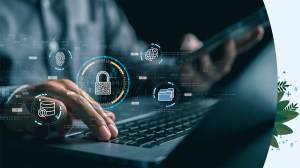Modern Work
NFTs, the Metaverse, and Digital HQs — Salesforce Execs Share 2022 Predictions

A record 4.4 million people quit their jobs in October, according to the Labor Department. That’s 3% of the nation’s workforce. It’s called the Great Resignation and companies looking to survive it must rethink how they operate — everything from what they provide employees, to corporate responsibility, to innovations that keep them at the top of the industry.
In this article, 12 Salesforce executives share what to expect in 2022, from the future of work and corporate responsibility to AI, NFTs and the metaverse.
The year of the employee
Workflow will take organizations from the Great Resignation to the Great Retention.
Organizations that give employees what they most want — flexibility, autonomy and choice about where they work, when they work and how they work — will be the most effective at attracting and retaining top talent. – Karen Mangia, VP Customer & Market Insights, Salesforce
Employees will be the number one stakeholder for businesses.
Those companies that create an environment for greater employee commitment and engagement will enjoy significantly improved top-line growth rates. – Tiffani Bova, Global Growth Evangelist, Salesforce
Those companies that create an environment for greater employee commitment and engagement will enjoy significantly improved top-line growth rates.
Tiffani Bova, Global Growth Evangelist, Salesforce
CIOs must drive collaboration across business and IT teams to make work seamless.
With everyone working from anywhere, our digital HQ will continue to become more important than our physical HQ in the coming year. In 2022, more companies will look to implement a strategy that empowers teams across their organization with easy access to the apps and data they need to do their jobs most effectively. CIOs will need to drive collaboration among the organization by enabling both IT and business teams to access, unlock and integrate data and apps in a secure, governed manner. – Brent Hayward, CEO, MuleSoft
Digital-first work will break the 9-to-5.
Companies that want to attract and retain top talent, and empower employees with the flexibility to do their best work, will shift to a digital-first approach. In 2022, more companies will build on this model by rethinking when, not just where, work happens. We are long overdue for a reinvention of the rigid 9-to-5 workday of back-to-back meetings. Future Forum research shows that 93% of workers want schedule flexibility, and that giving people more control over their calendars increases productivity and decreases stress. It also disproportionately improves the working lives of diverse groups, especially women with children. With a digital HQ, asynchronous collaboration tools and team-level agreements that limit the hours colleagues are expected to be on-call and “in sync,” we can cut back on meetings and give people more freedom to structure their days – unlocking greater productivity and deeper engagement in the process – Brian Elliott, SVP, Future Forum, Slack
We are long overdue for a reinvention of the rigid 9-to-5 workday of back-to-back meetings.
Brian Elliott, SVP, Future FOrum, Slack
The role of business as a platform for change
Corporations must shift from reactive to proactive to solve societal challenges.
Expectations have never been higher for companies to move the needle on the world’s greatest challenges — from climate change to widening inequality. To do this, corporations and funders must move from a reactive to proactive mode. We can’t just wait for another disaster to happen — we need to invest now in the strength and resiliency of our communities. This work will start with addressing inequities and keeping those furthest from success front and center. – Naomi Morenzoni, SVP, Philanthropy, Salesforce
Responsible organizations must prioritize data ethics.
With the COVID-driven shift to digital spaces, there’s a greater sense of responsibility around data ethics, privacy, and security. Entire market sectors became first-time stewards of sensitive data due to the pandemic. From travel and transport to hospitality, companies will have adapted a thoughtful mindset with regard to data, shifting to collect and use the right data, not the most data. – Paula Goldman, Chief Ethical and Humane Use Officer, Salesforce
From travel and transport to hospitality, companies [in 2022] will have adapted a thoughtful mindset with regard to data, shifting to collect and use the right data, not the most data.
PaulA Goldman, Chief Ethical and Humane Use Officer, Salesforce
Healthcare organizations have added responsibility in 2022.
COVID-19 increased the role of telehealth, making hybrid care an integral part of the future. Technology will drive down the cost of care, making it more accessible to underserved communities. In addition to implementing more hybrid care in the long-term, healthcare organizations must use their platform to actively fight against misinformation. By increasing transparency in communications and where information is coming from, healthcare organizations can help counteract today’s lack of trust. – Dr. Geeta Nayyar, Chief Medical Officer, Salesforce
The rise of AI and automation
With the rise of Ethics as a Service (EaaS), companies must hire AI ethicists.
This year we saw a range of new AI regulations proposed and passed in the US and beyond. These regulations spawned several startups offering AI governance products and Ethics as a Service (EaaS) providers. Companies that are developing AI will increasingly spin-up their own EaaS offerings within their professional service organizations. We will see a race to hire AI ethicists to become compliant with the new regulations, making AI ethicists in even greater demand than AI developers. – Kathy Baxter, Principal Architect, Ethical AI Practice, Salesforce
We will see a race to hire AI ethicists to become compliant with the new regulations, making AI ethicists in even greater demand than AI developers.
Kathy Baxter, Principal Architect, Ethical AI Practice
Natural language generation (NLG) will transform business.
Natural language generation (NLG) has already started appearing in consumer apps, such as ‘autocomplete’ in Gmail. In 2022, we will see the rise of NLG across business applications (e.g. Marketing and Commerce sectors will use NLG engines to generate marketing and website copy). We’ll also see different forms of NLG, like summarization, being used in sales and service sectors, to write summaries of calls and Zoom meetings – sometimes citing action items. Question-answering will also be more widespread. As a result, creating chatbots will be less laborious because the chatbots will learn to “read” knowledge bases and auto-generate appropriate responses to questions. This will not only save a huge amount of time and resource, but will enable organizations across industries to have more meaningful and impactful customer experiences. – Marco Casalaina, GM Salesforce Einstein, Salesforce
Talk-to-text will become speech-to-code.
This past year, we saw AI capable of generating its own code to construct increasingly complex AI systems. We will continue to see growth in both AI that can write its own code in different programming languages, as well as AI that allows people to simply speak their instructions. These speech-to-code engines will generate images, video, and code using natural commands without worrying about syntax, formatting, or symbols. Say “I’d like an image of a purple giraffe with orange spots, wings, and wheels instead of legs” and watch what the AI generates. – Yoav Schlesinger, Principal, Ethical AI Practice, Salesforce
Industry-transforming innovations leading the way
Pioneering brands will search for utility via NFTs.
Brands have been playing with NFTs for the past 18 months, however these efforts have largely been focused around art and novelty. The US Post Office has just released stamps as NFTs, but those stamps are only art and hold no utility other than their collectability. The novelty of art is only the starting value of what an NFT can be. To unlock their full potential, brands are going to have to start creating utility via the token. Time is a great example. They launched TimePieces, which is a collectible and has utility. Each NFT grants the owner unlimited access to Time’s content, special event access, and a few other small perks. In 2022, you’re going to hear a lot more about NFTs, and there will be winners and losers. Winners will move past NFT’s as simply collectable to find greater utility through the token. – Mathew Sweezey, Director, Market Strategy, Salesforce
In 2022, you’re going to hear a lot more about NFT’s, and there will be winners and losers. Winners will move past NFT’s as simply collectable to find greater utility through the token.
Mathew Sweezey, Director, Market Strategy, Salesforce
Make room for the metaverse to manage global supply chains.
In 2021, the whole world buzzed about the metaverse, with the initial use cases applied to the consumer world, like Nike’s partnership with Roblox, to create a virtual world. What surprised many was how quickly the Metaverse concept got adopted for global supply chain management. Now, executives are able to “tour” their supply chain operations from their chair at home or their desktop at work. Do they want a status report from the plant manager in Thailand or Taiwan? Or to find out what’s happening in shipping operations in China or the ports of LA or Long Beach? These new versions of supply chain control towers won’t happen overnight. They’ll require continued investments in great visualization tools, enhancements to integration platforms to handle real time video feeds, and access to many disparate systems. They’re also going to require high performance collaboration tools that allow executives to have real time conversations to determine the best course of action. – Bruce Richardson, Chief Enterprise Strategist, Market Strategy, Salesforce
Web 3.0 creates new business value for challenger and legacy brands
Web 3.0 is creating opportunities for incumbent and emerging businesses to reimagine operational models and products/assets that are open, collaborative, and collective. The difference with Web3 and previous incarnations of internet protocols models is that platforms are decentralized, open and ubiquitous, connected by trustless networks, and powered by encrypted, accountable distributed ledgers. For example, NFTs, tokens, and other crypto-based assets could also be distributed as part of innovative loyalty programs where customers become stakeholders. Or imagine offering physical and digital products as NFTs, authenticated and minted on a blockchain during every sale or resale. Homes, cars, luxury goods, can now all be tied to distributed systems of record that guarantee authenticity, linked to a historical value chain, providing individual ownership without any one centralized group facilitating each transaction. The value proposition changes from one of consumption to that of ownership. For customers, this becomes not only a matter of spending, but also investing in brands. – Brian Solis, VP, Global Innovation Evangelist, Salesforce
In 2022, the most innovative companies will prioritize their employees, be a platform for change, and embrace new technologies. Is your company prepared for the future of work?




